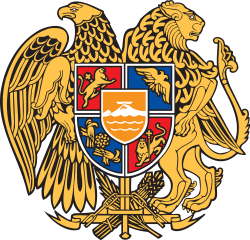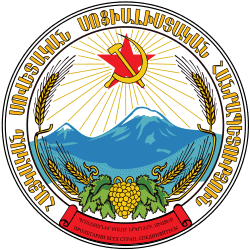Coat of arms of Armenia
| Coat of arms of Armenia Հայաստանի Զինանշան | |
|---|---|
 | |
| Details | |
| Armiger | Republic of Armenia |
| Adopted | April 19, 1992 |
| Escutcheon | Quarterly: 1; Gules, a lion passant facing to the sinister with a cross rising from its back Or, 2; Azure, a double headed eagle Or, 3; Azure, a roundel Or charged with an octofoil between two eagles trussed regardant and addrosed Or, 4; Gules, a Lion passant guardant holding a cross Or. On an Inescutcheon en surtout, a Landscape of Mount Ararat with the flood waters receding and Noah's ark at the summit, all Argent |
| Supporters | To the dexter, an eagle regardant Or,and to the sinister a lion regardant also Or |
| Compartment | Bundle of Wheat Flowers, Feather, Broken Chain, Ribon, and Sword[1] |
The national coat of arms of Armenia (Armenian: Հայաստանի զինանշանը, Hayastani zinanshan) was adopted on April 19, 1992, by the Armenian Supreme Council decision. On June 15, 2006, the law on the state coat of arms of Armenia was passed by the Armenian Parliament.
It consists of an eagle and a lion supporting a shield. The coat of arms combines new and old symbols. The eagle and lion are ancient Armenian symbols dating from the first Armenian kingdoms that existed prior to Christ. These symbols are found on the Armenian Highland from times immemorial. Numerous Armenian dynasties such as Artaxiad, Arsacid, Bagratuni and Rubenid, used these symbols as their royal insignia. Like other post-Soviet republics whose symbols do not predate the October Revolution, the current emblem retained one component of the Soviet one such as the Mount Ararat on the shield. Prior to 1992, Armenia had an emblem similar to all other Soviet Republics.
Symbolism
Shield
The shield itself consists of many components. In the center is a depiction of the Mount Ararat with Noah's Ark sitting atop it. According to tradition, the ark is said to have finally rested on the mountain after the great flood. Ararat is considered the national symbol of Armenia and thus is of principal importance to the coat of arms. Surrounding Mount Ararat are symbols of old Armenian dynasties. In the lower left portion of the shield, there are two eagles looking at each other, symbolizing the length of the Armenian territory during the reign of the Artaxiad Dynasty that ruled in the 1st century BC. In the upper left portion, there is a lion with a cross, the emblem for the Bagratuni Dynasty that ruled during the Middle Ages, between the 7th and 11th centuries. Under this dynasty, Armenia blossomed culturally, making its capital, Ani, one of the most important cultural, social and commercial centers of its time.[2] Bagratuni was destroyed by the Byzantine Empire's encroachment and by Seljuk conquests in the 11th century. In the upper right portion, there is a two-headed eagle, the emblem of the first dynasty to reign over a Christian Armenia, the Arsacid Dynasty of Armenia. Tiridates III of Arsacid Dynasty made Armenia the first Christian nation in 301. This dynasty ruled from the 1st century to 428. In the lower right portion, there is a lion with a cross, the emblem of the Rubenid dynasty. This dynasty reigned in Armenian Kingdom of Cilicia, a state that expanded and prospered during the 12th and 13th centuries, until the Mamelukes and Turks eventually conquered it.
Eagle and Lion
The eagle supports the shield on the left side of the coat of arms, while the lion on the right side. The eagle was the symbol of the Artaxiad Dynasty and later on the symbol of the Arsacid Dynasty of Armenia. It holds the Artaxiad Dynasty's branch of the shield. Whereas, the lion was the symbol of the Bagratuni Dynasty and later on the symbol of the Rubenid Dynasty. It holds the Rubenid Dynasty's branch of the shield. The eagle and the lion are a common theme for civilizations on the Armenian Highland. As such they have been represented throughout various Armenian dynasties.
Both of these animals were chosen because of their power, courage, patience, wisdom, and nobility in animal kingdom.
Five vital elements
Source:[1]
- The sword represents the power and strength of the nation, breaking the chains of oppression.
- The broken chain represents effort shown by the nation to gain freedom and independence.
- The wheat ears represent the hard working nature of the Armenian people.
- The feather represents the intellectual and cultural heritage of the Armenian people (as a quill pen).
- The ribbon represents the colors of the flag of Armenia.
History



Coat of arms of the First Republic of Armenia
The present-day Armenian coat of arms has its origins with the establishment of the First Republic of Armenia in 1918. In that year, an early variation of the coat of arms was adopted. The symbols on this earlier version were placed in a slightly different order and the eagle and lion have their tongues out, giving them a more menacing look. Only Mount Ararat (along with Little Ararat) are depicted while Noah's Ark is absent. The coat of arms was designed by architect and member of the Russian Academy of Fine Arts Alexander Tamanian and artist Hakob Kojoyan.[3]
Transcaucasian SFSR
In 1922, Armenia was incorporated into Transcaucasian SFSR with Georgia and Azerbaijan. The coat of arms of the Transcaucasian SFSR was adopted by the government of the Transcaucasian SFSR. It is uncertain when exactly it was adopted. It incorporates designs from each of the three major groups that combined in the Transcaucasian SFSR, the Armenians, Azeri and Georgians, and unusually features Islamic art and communist elements side by side. The latticework in the star itself bespeaks the former coat of arms of Georgia from 1918–1921 and adopted again from 1991–2004; the crescent moon represents the Muslim Azeris, on a background depicting the national symbol of the Armenians, Mount Ararat.
Soviet coat of arms
In 1937, a new coat of arms was adopted. Like the DRA coat of arms, this coat prominently featured Mount Ararat along with the Soviet hammer and sickle and red star behind it. The inclusion of Ararat brought objections from Turkey because the mountain is part of its territory. The Kremlin retorted that although the Turkish symbol was the crescent, surely it did not mean that they laid claim to the moon.[4] The Soviet Union broke apart in 1991 and Armenia thus became an independent republic. In 1992, a slightly modified version of the DRA's coat of arms was adopted and has remained in place ever since.
Use
The coat of arms of the Republic of Armenia may be used on the monetary units, orders and medals of the Republic of Armenia.[5]
References
- 1 2 "Flag and Coat of Arms". Armenica.org. Retrieved October 5, 2016.
- ↑ "Armenia: Coat of arms". CRW Flags. Retrieved October 5, 2016.
- ↑ "State symbols of the Republic of Armenia". The Office to the President of the Republic of Armenia. Retrieved October 5, 2016.
- ↑ Louis, Victor and Jennifer. The Complete Guide to the Soviet Union. New York, 1976. p. 98
- ↑ "The Law of the Republic of Armenia On the coat of arms of the Republic of Armenia".
External links
- Coat of arms of Armenia at Flags of the World
- The Evolution of the Armenian Flag and Coat of Arms at the Wayback Machine (archived April 4, 2001)
- Armenica.org - Symbolic values and information about the Armenian flag and coat of arms
- National Coat of Arms of the Republic of Armenia - Official website
- Atlas of Conflicts: Examples of Old Armenian Heraldry

